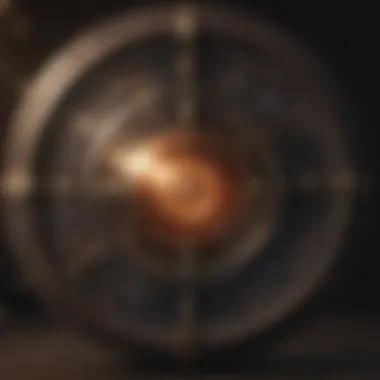Understanding Your Current Natal Chart's Impact


Intro
Astrology, an ancient practice rooted in the observation of celestial bodies, offers a window into understanding ourselves and the universe we inhabit. Through the lens of a natal chart, it becomes easier to grasp the interplay between planetary positions at the time of our birth and the nuances of our personalities, relationships, and paths in life. This guide embarks on a journey to decode the current natal chart, extracting insights and implications that can enrich our understanding of ourselves and those around us.
Today, as we navigate the current cosmic alignment, it’s vital to gain knowledge about the foundational elements of a natal chart. Many enthusiasts and practitioners often wonder how to interpret this intricate map of celestial energy. By delving into features such as zodiac signs, planetary aspects, and the houses wherein these celestial influencers reside, one can begin to appreciate the multitude of layers shaping individual destinies.
Let's take a fresh look at each of these elements and explore their relevance, leading up to a comprehensive understanding of how the current cosmic dance echoes through our lives.
Characteristics of Each Zodiac Sign
Every zodiac sign embodies unique characteristics that contribute to our individual personalities. The 12 signs of the zodiac can be traced back to ancient civilizations, each sign linked to specific traits and energies. Whether fierce and fiery or serene and grounded, understanding these nuances can breathe life into the chart.
Overview of Personality Traits
- Aries: Adventurous, competitive, and sometimes impulsive.
- Taurus: Stable, reliable, and possessive.
- Gemini: Curious, adaptable, and sometimes indecisive.
- Cancer: Empathetic, intuitive, and prone to mood swings.
- Leo: Confident, charismatic, but can be self-centered.
- Virgo: Attention to detail, practical, and sometimes critical.
- Libra: Diplomatic, balanced, yet indecisive.
- Scorpio: Passionate, enigmatic, and can be secretive.
- Sagittarius: Optimistic, adventurous, but often restless.
- Capricorn: Disciplined, ambitious, can be pessimistic.
- Aquarius: Innovative, independent, sometimes aloof.
- Pisces: Compassionate, artistic, but can be escapist.
Strengths and Weaknesses
Every sign has its strengths and weaknesses. For instance, while Leo's confidence can inspire others, it may also lead to arrogance. On the flip side, Virgo's attention to detail is an asset in many situations, but it can sometimes come off as overly critical.
Compatibility with Other Signs
Understanding how signs interact can offer profound insights into relationships:
- Fire Signs (Aries, Leo, Sagittarius) generally connect well with each other, thriving on excitement.
- Earth Signs (Taurus, Virgo, Capricorn) find stability and comfort in one another, often forming lasting bonds.
- Air Signs (Gemini, Libra, Aquarius) bring intellect and communication, fostering dynamic exchanges.
- Water Signs (Cancer, Scorpio, Pisces) create deep emotional connections, often understanding each other on an instinctual level.
The enjoyment of a cozy companionable relationship or a fiery debate may boil down to recognizing these mutual compatibilities, which are essential for harmonious interactions.
Understanding these characteristics is just the beginning. As we traverse through the components of natal charts, we uncover layers of implications that can shape our lives, and ultimately, our futures.
"The stars incline; they do not compel." - A reminder that while astrology is a guiding light, choice remains the heart of destiny.
Prolusion to Natal Charts
Natal charts hold a significant place in the realm of astrology, serving not just as maps of the heavens at one’s birth, but as intricate blueprints of the individual’s potential, personality, and life journey. Understanding what a natal chart is can open doors to deeper self-awareness and insights into how celestial bodies interact with our lives.
The Concept of a Natal Chart
A natal chart, often referred to as a birth chart, is essentially a snapshot of the sky at the exact moment of a person's birth. This chart details the positions of the sun, moon, planets, and other celestial points, plotted against the backdrop of the twelve zodiac signs and the twelve astrological houses. Each of these components carries specific meanings which can offer explanations for various aspects of a person’s character and experiences.
For example, if the chart shows Venus in Libra, one could expect a deep appreciation for beauty and harmony in relationships. The complex interplay of these celestial bodies forms a unique tapestry, unique to each individual, embodying both strengths and challenges.
Importance in Astrology
The natal chart is more than just a collection of symbols; it's a key that unlocks the door to understanding life’s nuances. Astrologers often analyze these charts to glean insights into what makes a person tick, how they interact with the world, and the life lessons they might encounter.
Here are some ways in which natal charts are crucial in astrology:
- Personal Insights: They can reveal tendencies in behavior, emotions, and motivations, providing a clearer picture of one’s personal strengths and weaknesses.
- Life Path Understanding: By comprehending where the planets sit, astrologers can suggest paths for personal growth, often aligning with significant life events.
- Relationship Dynamics: Understanding a partner's chart can illuminate the dynamics of a relationship, shedding light on compatibility and potential challenges.
By examining these elements closely, individuals can achieve a greater sense of clarity and direction in their lives. Therefore, a deep dive into the concept of natal charts can provide a profound understanding not just of oneself, but also of relationships with others and the universe as a whole.
"Astrology does not lay claim to a science, but it reveals a map of the cosmos, illuminating the essence of our life’s journey."
Through this article, readers will embark on a thorough exploration of the natal chart, its components, and the current cosmic influences that shape their lives. This is an invitation to engage with the cosmos in a way that is insightful and deeply personal.
Components of a Natal Chart
The components of a natal chart are like the ingredients in a rich, complex dish. Each element adds its own flavors and nuances, creating a unique blend that shapes an individual's personality and life experiences. Understanding these components not only broadens one’s knowledge of astrology but also deepens one's insight into personal motivations, challenges, and potential paths forward.
Houses: What They Represent
In the realm of astrology, houses are akin to the rooms in a house—each serves a specific purpose and reflects distinct areas of life. There are twelve houses in a natal chart, each corresponding to vital themes and aspects. For instance, the first house, often called the Ascendant or the Rising Sign, reveals outward behavior and self-image.
- 1st House: Self and identity
- 2nd House: Money and possessions
- 3rd House: Communication and learning
- 4th House: Home and family
- 5th House: Creativity and pleasure
- 6th House: Health and service
- 7th House: Partnerships and marriage
- 8th House: Transformation and shared resources
- 9th House: Philosophy and travel
- 10th House: Career and public life
- 11th House: Friendships and aspirations
- 12th House: Subconscious and spirituality
Every house needs to be analyzed in conjunction with the planets placed within them for a complete understanding of how energies manifest.


Planets and Their Influences
The planets in astrology act like the cast of a play, each bringing its own set of characteristics and energies to the performance of life. Each planet has a unique role to play, influencing individual traits and life events. For example, the Moon resonates with emotions, while Saturn represents structure and discipline.
- Sun: Core identity, ego, and vitality
- Moon: Emotions and inner self
- Mercury: Communication and thought processes
- Venus: Love and harmony
- Mars: Action and desire
- Jupiter: Growth and expansion
- Saturn: Lessons, limitations, and responsibility
- Uranus: Innovation and rebellion
- Neptune: Intuition and dreams
- Pluto: Power and transformation
These planets traverse the houses, bringing their energies to bear on various aspects of life, influencing how one experiences relationships, career decisions, and personal challenges.
Zodiac Signs: Characteristics and Traits
Zodiac signs are the language of astrology—each sign has its own set of traits and tendencies. When planets occupy certain signs in your chart, their energies get flavored by those characteristics. For example, Jupiter in Capricorn may express growth through practical and cautious means, while Jupiter in Sagittarius would be more adventurous and expansive.
- Aries: Courageous, impulsive, and energetic
- Taurus: Stable, sensual, and determined
- Gemini: Curious, adaptable, and communicative
- Cancer: Nurturing, emotional, and protective
- Leo: Charismatic, confident, and creative
- Virgo: Analytical, detail-oriented, and practical
- Libra: Diplomatic, charming, and fair-minded
- Scorpio: Intense, passionate, and secretive
- Sagittarius: Optimistic, adventurous, and philosophical
- Capricorn: Disciplined, ambitious, and patient
- Aquarius: Innovative, unique, and humanitarian
- Pisces: Empathetic, artistic, and dreamy
Understanding these signs helps to decode the personal features and inner workings of oneself and others, providing a holistic picture of the natal chart.
Keep in mind: The interplay between houses, planets, and signs crafts a unique astrological fingerprint that affects motivations, challenges, and growth trajectories. Therefore, getting to know these elements isn't just about intellectual curiosity; it’s a gateway to personal evolution.
Understanding the Current Cosmic Alignment
Understanding the current cosmic alignment is like finding the rhythm in a symphony of celestial bodies. This section hones in on the relevance of these planetary positions, and how they intertwine with the energies that influence our daily lives. The cosmic alignment sheds light on current events, personal experiences, and even the subtle waves our emotional landscapes ride each day.
The current cosmic alignment begins with an assessment of where the planets are positioned at any given time. Each position is a piece of a larger puzzle, influencing everything from moods to milestones. One might consider this as a map that offers guidance through the turbulence of existence. The insights derived from these alignments can lead to a clearer understanding of not only oneself but the unfolding patterns of life. It’s saying, "Here’s what’s happening above, and here’s how it may shape what’s Happening below."
Current Planetary Positions
Currently, the planets are spreading out across the zodiac, each carrying its own energy signature. Let’s take a moment to consider some key players in the planetary dance:
- Mars might be agitating the air, igniting passions and perhaps leading to a bit of conflict.
- Venus, on the other hand, soothes interactions, enhancing relationships and aesthetics.
- Jupiter expands possibilities, offering opportunities for growth, especially when placed favorably.
When we thread together these individual influences, we begin to sense the greater dynamic. It’s crucial to note how transiting planets interact with individual natal chart placements. For instance, if your natal Venus is being influenced by a transiting Mars, you might find yourself craving, not just love, but intensity in your relationships.
The positioning of the planets also relates to the houses they occupy in your natal chart. Each house addresses specific life themes. For example, if Mercury is in your first house, communication will likely become a key focus, shaping how you express your identity.
Eclipses and Their Impact
Eclipses, those celestial heavily-marked events, act as catalysts for change. They mark significant transitions, often prompting deep introspection and sometimes upheaval. Each eclipse carries its own essence; a solar eclipse often represents new beginnings, while a lunar eclipse could signify endings or revelations.
The impact of an eclipse goes beyond the moment it occurs. It can reverberate through your life, bringing past issues to the forefront, especially if they coincide with key personal points in your natal chart. If you have a natal planet located near the degree of an eclipse, hold onto your hat! You might be in for an experience that propels you toward significant personal development.
In essence, understanding these cosmic alignments lays the groundwork for interpreting current experiences. Each ebb and flow of cosmic energy serves as a reminder of the interconnectedness of our lives with the universe. By paying close attention to planetary positions and eclipse cycles, one can harness these influences to navigate the complexities of life with greater awareness.
Cosmic alignment isn’t just about gazing at the stars; it’s about understanding how their movements reflect and affect your own journey.
Astrology isn’t merely a tool for prediction; it cultivates self-awareness.
By weaving these insights together, the current cosmic alignment becomes a vital aspect of understanding personal and collective experiences that shape our lives.
Interpreting Your Current Natal Chart
To grasp the complex dance of the cosmos as it relates to your life, understanding your current natal chart is essential. It provides not just a map of the celestial landscape at your time of birth but also a guide, rich with potential insights and implications for both personal and spiritual development. When you decode your chart, you’re essentially translating it into your own language—a language of symbols, narratives, and energies that resonate with your experiences.
Analyzing Planetary Aspects
Every celestial body in your natal chart holds a unique significance, especially when we consider their aspects—these are the angles formed between planets. They reveal how the energies of different planets interact, showcasing both harmonies and tensions in your life. For instance, if your Sun is in a trine aspect to Jupiter, this implies a natural flow of optimism and opportunity in your personal expression. It might suggest success and a positive attitude toward life achievements.
Alternatively, consider a square aspect between Mars and Venus. This might reveal underlying conflicts between your desires and actions. It can signify relationship challenges or a struggle to balance assertiveness and affection. In interpreting these aspects, it’s crucial to assess their nature—harmonious or challenging—and how they influence your life journey.
As you dive deeper, pay attention to transiting aspects as well. These are current movements of planets influencing your natal positions. For example, if Pluto transits over your Moon, expect transformative shifts in emotional realms. It’s a process of letting go and renewing, often leading to significant personal growth.
Identifying Dominant Influences
In each natal chart, certain elements tend to stand out, creating a sort of energy hierarchy. Identifying these dominant influences—whether they be planets, signs, or houses—helps you understand the overarching themes of your life.
Consider the planetary rulerships and their placements. If you find Jupiter sitting prominently in your chart, you may experience expansive opportunities. However, if Saturn holds sway, the lessons might lean towards discipline and responsibility. This hierarchy informs not just potential gifts but also challenges you may face.
You might also want to reflect on the angular planets—those occupying the angles of the chart—often called the Ascendant, Descendant, Midheaven, and Imum Coeli. Their presence highlights essential qualities that play a significant role in shaping your life's narrative.
Moreover, compile a checklist and evaluate your chart with these guiding questions:


- Which planets are in their dignities (rulership, exaltation)?
- Do you have a stellium (three or more planets in the same sign/house)?
- Are there any empty houses, and what does that signify for your life focus?
Understanding these factors can lead to revelations about your personality and motivations, offering clarity on past experiences and manifesting future aspirations.
Key Insight: Your current natal chart is not static; it reflects ongoing evolution influenced by transits and individual experiences. Stay attuned to its changing nature as you navigate life’s journey.
Practical Applications of Your Current Natal Chart
Grasping the practical sides of your current natal chart can be a game changer. It’s not just about understanding where the planets sit; it’s about recognizing how their placements affect your daily life, personal choices, and growth trajectory. When you get into the nitty-gritty, the natal chart morphs into a tailored guide for your existence, full of insights waiting to reveal themselves.
Personal Development and Growth
Personal development isn't just a buzzword; it's a lifelong journey. Your natal chart is like a roadmap in this process. Every planet and aspect has a narrative to tell, guiding you through the nuances of who you are and what you can become.
- Self-Reflection: By analyzing the positions of planets, especially the slow-moving giants like Saturn and Jupiter, you can identify periods of growth and challenge. For instance, if your Saturn is making a square to your Sun, it might indicate a time of intense self-doubt. Through this understanding, you can strategize effective coping mechanisms.
- Strengths and Weaknesses: The houses in your chart highlight your strengths and potential areas for improvement. If your 2nd house is heavily populated with planets, it could mean a strong inclination towards financial stability. Recognizing this in yourself allows you to leverage your strengths when setting goals.
- Life Phases: The transits affecting your natal chart offer snapshots of potential life phases. A favorable transit to your Moon can sometimes mean an emotionally enriching period, while challenging aspects might signal a time for introspection. Knowing this, you can align your personal development efforts with these cosmic cues.
By engaging with your natal chart, personal growth shifts from being a vague aspiration to a structured and insightful pursuit.
Navigating Relationships
Relationships can be tricky waters to navigate, but your current natal chart can offer guidance similar to a lighthouse guiding ships in a storm. Here are a few ways to make astrological interpretations work for your interpersonal connections:
- Understanding Compatibility: Instead of fishing around in the dark trying to understand your relationships, the synastry between charts can reveal underlying connections. By comparing your Venus placements with those of your partner, you can pinpoint areas of attraction as well as potential friction.
- Communication Styles: The position of Mars and Mercury in your chart can shed light on how you express yourself and how you perceive communication. If your Mercury squares your partner's Mars, misunderstandings might abound. Recognizing this can prompt discussions on how to bridge communication gaps.
- Navigating Conflict: Every relationship hits bumps along the road. By examining the current transits, you can assess the impact on your relationships. For example, if Mars is squaring your Venus, tensions may arise; being aware gives you a head’s up to address these confrontations more effectively.
- Timing and Opportunities: Certain astrological periods are favorable for nurturing relationships. For instance, if your progressed Moon moves into your partner's 7th house, it could signify a great time for deepening emotional ties.
Through the lens of astrology, relationships transform into interconnected webs, full of potential for mutual growth and understanding. This perspective not only enriches bonds but also fosters empathy and patience.
Astrological insights serve as a mirror, reflecting not just who you are but also how to co-exist harmoniously with others.
The Role of Transits in Current Natal Interpretation
Transits hold a crucial place in natal chart analysis, acting as a bridge between a person’s inherent traits and how those traits express themselves through life’s myriad experiences. When discussing the role of transits, it is paramount to understand that they are not merely fleeting events; they represent the ongoing movements of celestial bodies which interact with the positions of planets in your natal chart. These interactions breathe life into the static blueprint of your birth chart, providing context and clarity to ongoing influences in your life.
Transits Explained
Transits occur when planets move through the sky and form angles, or aspects, to the positions of planets in your natal chart. This can influence various areas of your life, triggering potent energy shifts. For example, when Jupiter—the planet of expansion—forms a conjunction with your natal Venus, which symbolizes love and beauty, it may spark an increase in romance or financial opportunities. Conversely, a transit from Saturn, known for its restrictive qualities, can bring challenges that test your discipline and commitment.
Think of transits as the rhythm to your astrological symphony. Each time a planet makes a movement, it resonates with specific aspects of your life, highlighting where growth, conflict, or resolution may occur. These transiting energies can manifest in ways that can be both supportive and challenging, and discerning their effects requires a keen understanding of both the natal chart and the current cosmic landscape.
Significance of Transit Timing
Timing in astrology is everything. Not only do the individual planets carry unique energies, but the timing of their transits also plays a significant role in how these influences are experienced.
- Transits unfold at different durations:
- Critical angles matter: Certain aspects—especially conjunctions, squares, and oppositions—tend to carry a heavier weight, often indicating periods of potential upheaval or significant growth.
- Shorter transits, like those of the Moon, can create rapid emotional fluctuations.
- Longer transits from Jupiter or Saturn may shape broader life themes over years.
Understanding exactly when a transit will occur can not only help you navigate difficulties but can also be an avenue for seizing opportunities when they arise. An important aspect to consider is the period of influence. Sometimes, transits build up their energies long before they reach their peak and can linger long after they pass. Therefore, keeping an eye on transit timelines can offer a strategic advantage and deeper comprehension of what energies are at play.
"Astrology is a language. If you understand this language, the sky speaks to you." — Dane Rudhyar
Chart Rectification: Finding Accurate Birth Data
Chart rectification is a crucial aspect of astrological practice, especially when it comes to interpreting one’s natal chart. This process involves determining the exact time of birth—something that can profoundly influence the insights drawn from a natal chart. The accuracy of one’s chart hinges upon knowing the precise moment of birth; small variances in time can lead to significant differences in planetary positions and house placements. Failing to rectify a chart can render interpretations misleading or even entirely off the mark.
In this section, we will explore the importance of chart rectification and provide clear steps for astrologers to ensure they gather accurate birth data.
Why Chart Rectification Matters
When we talk about chart rectification, we’re essentially addressing a fundamental question: How accurate is your natal chart? Astrologers often find themselves working with clients who may not have their time of birth or who have faced ambiguities in records. Here are several reasons why rectification matters:
- Precision in Interpretation: The planets, their placements, and the houses they occupy offer insights into various life aspects. When the birth time is off, those insights can be skewed.
- Life Events Correlation: Success in astrology involves relating planetary transits to significant life events, a process heavily reliant on accurate birth data. Errors can lead to incorrect predictions and analyses.
- Personalization of Astrological Insight: Each person exhibits unique traits influenced by their individual cosmic setup. Chart rectification allows a more tailored interpretation that accounts for all nuances.
"Without correct birth data, every astrological inquiry runs the risk of being a shot in the dark."
Steps to Rectify Your Chart
The process of chart rectification involves certain steps and considerations that can help pinpoint the accurate time of birth. Here are some methods to consider:


- Interviewing the Client: Begin by asking questions about significant life events, both positive and negative. Delve into the timing of these events as often they can correlate with notable planetary transits.
- Astrological Techniques: Utilize techniques like solar arc directions, secondary progressions, or even event charts to approximate the likely birth time based on life milestones.
- Rectification Software: There are dedicated online resources and software designed to assist with rectification. They can run compatibility checks against historical events in the client’s life.
- Cross-checking Data: If possible, review family records or consult with relatives. Sometimes, a family member may have a precise memory of the birth event that can aid in timing accuracy.
- Trial and Error: This is not an uncommon method. Astrologers may run through different potential times, checking which aligns with significant events in the client’s life.
By undertaking the process of chart rectification, you sharpen the tools you need to deliver astrological readings that flourish in precision and insight. Remember, accurate birth data lays the groundwork for more meaningful astrological interpretations, ultimately enhancing the value of your practice.
Astrology Software and Tools
In the modern age, software tools and online resources have revolutionized the way we engage with astrology. These tools not only present us a way to better analyze our natal charts but also enhance our understanding of the intricate patterns woven by the cosmos. With a myriad of astrology software options available, it can be overwhelming to find the right fit. Choosing wisely can mean the difference between a superficial grasp and a deep, practical insight into your natal chart and current cosmic alignments.
Choosing the Right Software
Not all astrology software is created equal, and with different tools tailored for various levels of expertise, it’s vital to choose one that meets your unique needs. Factors to consider include:
- User Interface: A clean, intuitive layout can make all the difference, especially if you’re just starting out. Select software that allows you to navigate effortlessly.
- Features and Tools: Look for software that offers comprehensive features like real-time ephemeris, aspect grids, and transit tracking. Some software might also include advanced features such as harmonics, which can provide deeper insights.
- Customization Options: The ability to personalize your natal chart will allow a more tailored reading. Some programs let you adjust house systems or input event charts.
- Support and Resources: Ensure that the software has adequate support. Tutorials and user guides enhance the overall experience and make learning more accessible.
- Price Point: There are free tools as well as premium options that offer extensive features. Balance your budget with the features most important to you.
Once you identify a few contenders, it’s wise to test their demo versions, if available. This hands-on experience will provide valuable insight into how well the software aligns with your approach to astrology.
Using Online Tools for Analysis
In addition to dedicated software, there's a vast array of online tools that can enhance your astrological analyses. These tools serve as excellent supplements, especially for those seeking a quick overview or detailed insights without the need for extensive setup. Here’s how you can leverage these resources:
- Natal Chart Generators: Websites equipped with chart generation tools can provide instant access to your astrological information. Many sites, such as Astro.com, enable you to generate a natal chart based on your date, time, and place of birth.
- Compatibility Calculators: If you're interested in relationship dynamics, online calculators that assess synastry can highlight compatibility factors, revealing how individual charts interact.
- Transits and Progressions: Some platforms allow users to track current planetary transits and their implications on your natal chart, offering an essential view of how cosmic shifts may influence your life.
"Astrology tools are like an artist's palette; they offer a range of colors to express deeper truths about our lives."
While utilizing these online tools, keep in mind that the depth of interpretation can vary significantly. They can deliver quick insights but often lack the nuanced analysis that dedicated software or professional astrologers provide. Thus, combining both software and online tools could yield a more well-rounded understanding of your current natal chart.
In essence, astrology software and tools are not just gadgets but essential companions on your astrological journey. They empower you to connect the dots between cosmic alignments and personal experiences, enhancing both your knowledge and intuition in the practice.
Connecting Theory and Practice
Understanding the current natal chart is not merely an academic endeavor. It's about weaving together personal experiences and theoretical knowledge. This connection can transform abstract concepts into applicable insights that resonate deeply with our lives. In this section, we’ll explore how to bridge the gap between theoretical astrology and practical application, enriching our comprehension of the self and the cosmic influences at play.
Bridging Personal Insights with Astrology
When we delve into astrology, we often uncover personal themes that echo through our lives. The placements of planets in our natal chart can reveal patterns in our behaviors, desires, and conflicts.
The magic begins when these astrological interpretations are linked to our daily realities. For instance, one might find that having Jupiter in the 5th house plays out as a zest for exploration in creative activities or romance. This can reflect into one's hobbies or even how they nurture relationships. Each time we draw upon our knowledge of astrological charts, we should ask ourselves, "How does this resonate with my experiences?" This introspection helps in realizing that the stars are not just distant entities; they reflect our innermost struggles and triumphs.
- Connecting your emotions to specific planetary alignments can help you better navigate your life's challenges.
- Understanding the correlation between cosmic patterns and your choices can lead to growth and self-awareness.
For instance, if someone is experiencing a tough period during a Saturn return, recognizing that this phase is part of a larger astrological cycle may alleviate feelings of isolation or despair. Instead, it can be seen as a time for maturation and reevaluation of personal goals.
Sharing Experiences with the Community
Astrology flourishes in community. When we share our personal insights, we create a tapestry of experiences that enriches everyone's understanding of the cosmic landscape. Engaging in discussions, whether through online platforms such as Reddit or Facebook groups, can foster a sense of belonging. It is here where we cultivate a shared language of the stars.
Consider how recounting your journey through a particular transit, like Uranus squaring your Sun, might resonate with another. This exchange can lead to collective epiphanies, as others might be navigating similar astrological challenges.
Moreover, writing blog posts, participating in local astrology meetups, or even hosting virtual workshops can serve as a wonderful platform for interaction. By sharing stories and insights:
- You may find unexpected support.
- Collectively solve astrology-related puzzles by garnering various perspectives.
- Validate experiences that may otherwise feel unique.
The interconnectedness of community not only reinforces our understanding of astrology but also reminds us that our celestial journey is shared, multifaceted, and ever-evolving.
Ending: The Value of Your Current Natal Chart
Understanding your current natal chart extends beyond mere curiosity; it serves as an insightful guide that can illuminate various facets of your life. Deep analysis of this chart reveals patterns that can be crucial when navigating personal challenges or enhancing your strengths. Furthermore, it can enrich your understanding of your interactions with others and how cosmic tides might be steering these relationships.
As discussed earlier, the current alignment of planets, along with their respective houses and aspects, provides a unique snapshot of your life's potential at any given moment. Whether the sun is casting its rays in your fifth house of creativity or a retrograde Mercury whispers miscommunications in your third house of communication, these elements can directly influence your daily experiences.
"Astrology does not dictate your destiny; it simply marks the path you have the choice to tread."
In the realms of self-awareness and growth, employing your natal chart can prove beneficial. By recognizing astrological influences, you can confront personal limitations while celebrating your potential. Planning major life decisions attuned to your chart can lead to more favorable outcomes, making the familiarity and understanding of your natal factors pivotal in your journey.
Summarizing Key Takeaways
- Personal Insights: The current chart helps individuals recognize their unique traits, strengths, and weaknesses.
- Timing for Decisions: Aligning personal timing with cosmic cycles can bring enhanced clarity for decision-making.
- Relationship Dynamics: Understanding how planetary influences interact within personal relationships can deepen intimacy and foster harmonious connections.
- Self-Development: The natal chart can guide personal growth, offering insights into potential challenges and triumphs.
- Future Paths: Recognizing patterns can help in foreseeing future hurdles and preparing for them accordingly.
Future Directions in Natal Astrology
As we march onward, the future of natal astrology looks promising, particularly with the rise of technology. Astrology software is continually evolving, making complex insights more accessible.
- Online Communities: Platforms such as Reddit and Facebook groups allow astrologers to share insights, experiences, and advice about natal charts.
- Integration with AI: Tools are emerging that harness artificial intelligence to offer personalized readings or answers in real-time.
- Cross-disciplinary Studies: We might see more integration with psychology and sociology to interpret natal charts through broader lenses, emphasizing the human experience.
- Environmental Influences: Considering how astrological readings can work in conjunction with personal environment factors like location and time of year could refine astrological practices.
- Interconnectivity with Global Events: Natal charts can be studied in relation to major world events, providing a more collective perspective.
In essence, the advancing landscape of natal astrology fosters a vibrant curiosity for enthusiasts and professionals. As each cosmic event unfolds, being attuned to your chart will allow you to navigate the waves of life with insight and intention.







